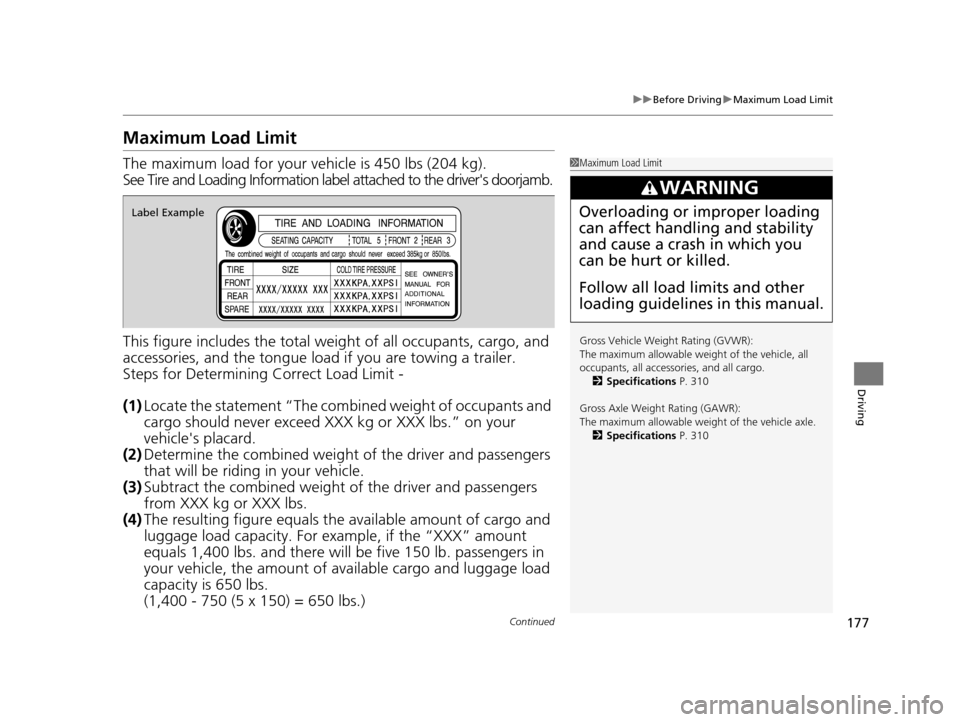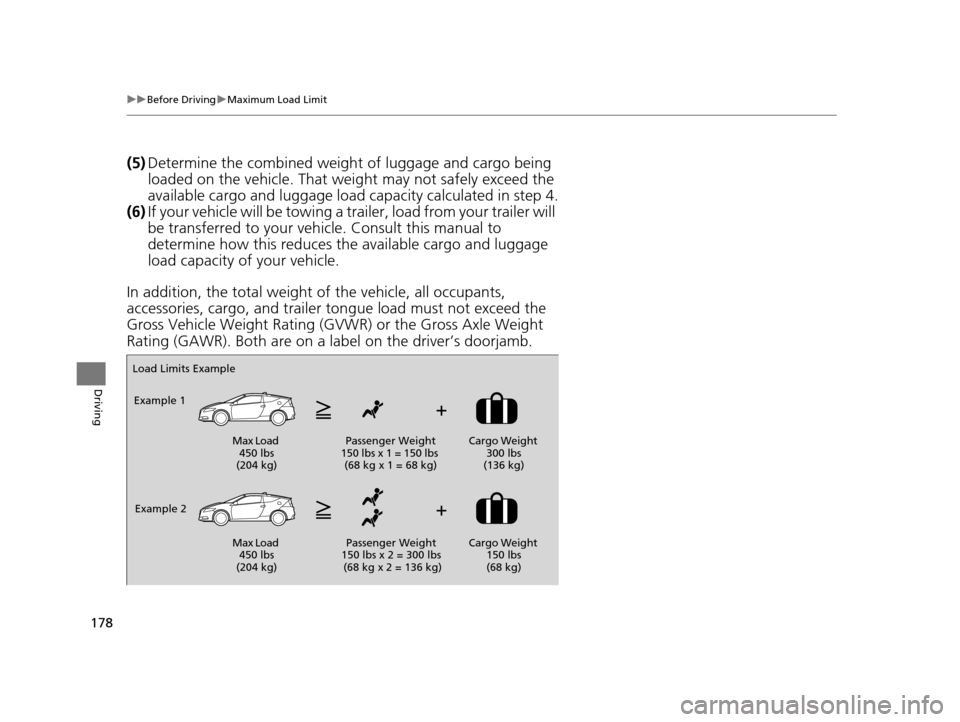Page 174 of 329

173
Driving
This chapter discusses driving, refueling, and information on items such as accessories.
Before DrivingDriving Preparation .............................. 174
Maximum Load Limit............................ 177
Towing a TrailerTowing Your Vehicle ............................ 179When DrivingStarting the Engine .............................. 180
Precautions While Driving..................... 183
Continuously Variable Transmission...... 184
Shifting ................................................ 185
Shifting ................................................ 190
Continuously variable transmission models
Manual transmission models
Auto Idle Stop ..................................... 193
Auto Idle Stop ..................................... 196
3-Mode Drive System........................... 199
Plus Sport System ................................ 200
Cruise Control ..................................... 202
Vehicle Stability Assist (VSA®), aka Electronic
Stability Control (ESC), System ........... 205
Tire Pressure Monitoring System (TPMS) ........ 207
Tire Pressure Monitoring System (TPMS) -
Required Federal Explanation ............. 208
BrakingBrake System ....................................... 210
Continuously variable transmission models
Manual transmission models
Anti-lock Brake System (ABS) ................ 212
Brake Assist System .............................. 213
Parking Your VehicleWhen Stopped ..................................... 214Multi-View Rear Camera .................. 215
Rearview Camera ............................. 216
Refueling
Fuel Information ................................... 218
How to Refuel ...................................... 219
Fuel EconomyImproving Fuel Economy....................... 221Accessories and Modifications ........ 222
15 CR-Z-31SZT6400.book 173 ページ 2014年8月1日 金曜日 午後1時59分
Page 178 of 329

177
uuBefore Driving uMaximum Load Limit
Continued
Driving
Maximum Load Limit
The maximum load for your ve hicle is 450 lbs (204 kg).
See Tire and Loading Information label attached to the driver's doorjamb.
This figure includes the total weig ht of all occupants, cargo, and
accessories, and the tongue load if you are towing a trailer.
Steps for Determining Correct Load Limit -
(1) Locate the statement “The comb ined weight of occupants and
cargo should never exceed XXX kg or XXX lbs.” on your
vehicle's placard.
(2) Determine the combined weight of the driver and passengers
that will be riding in your vehicle.
(3) Subtract the combined weight of the driver and passengers
from XXX kg or XXX lbs.
(4) The resulting figure equals the available amount of cargo and
luggage load capacity. For example, if the “XXX” amount
equals 1,400 lbs. and there will be five 150 lb. passengers in
your vehicle, the am ount of available cargo and luggage load
capacity is 650 lbs.
(1,400 - 750 (5 x 150) = 650 lbs.)1 Maximum Load Limit
Gross Vehicle Weight Rating (GVWR):
The maximum allowable weight of the vehicle, all
occupants, all accesso ries, and all cargo.
2 Specifications P. 310
Gross Axle Weight Rating (GAWR):
The maximum allowable weight of the vehicle axle. 2 Specifications P. 310
3WARNING
Overloading or improper loading
can affect handling and stability
and cause a crash in which you
can be hurt or killed.
Follow all load limits and other
loading guidelines in this manual.Label Example
15 CR-Z-31SZT6400.book 177 ページ 2014年8月1日 金曜日 午後1時59分
Page 179 of 329

178
uuBefore Driving uMaximum Load Limit
Driving
(5) Determine the combined weight of luggage and cargo being
loaded on the vehicle. That we ight may not safely exceed the
available cargo and luggage load capacity calculated in step 4.
(6) If your vehicle will be towing a tra iler, load from your trailer will
be transferred to your vehicl e. Consult this manual to
determine how this reduces the available cargo and luggage
load capacity of your vehicle.
In addition, the total weight of the vehicle, all occupants,
accessories, cargo, and trailer tongue load must not exceed the
Gross Vehicle Weight Rating (GVW R) or the Gross Axle Weight
Rating (GAWR). Both are on a label on the driver’s doorjamb.
Load Limits Example
Example 1
Max Load 450 lbs
(204 kg) Passenger Weight
150 lbs x 1 = 150 lbs (68 kg x 1 = 68 kg) Cargo Weight
300 lbs
(136 kg)
Example 2 Max Load 450 lbs
(204 kg) Passenger Weight
150 lbs x 2 = 300 lbs
(68 kg x 2 = 136 kg) Cargo Weight
150 lbs
(68 kg)
15 CR-Z-31SZT6400.book 178 ページ 2014年8月1日 金曜日 午後1時59分
Page 180 of 329
179
Driving
Towing a Trailer
Your vehicle is not designed to tow a trailer. Attempting to do so can void your
warranties.
Towing Your Vehicle
Your vehicle is not designed to be towed behind a motor home. If your vehicle needs
to be towed in an emergency, refer to the emergency towing information.
2Emergency Towing P. 305
15 CR-Z-31SZT6400.book 179 ページ 2014年8月1日 金曜日 午後1時59分
Page 185 of 329

uuWhen Driving uContinuously Variable Transmission
184
Driving
If there is a strong impact with something under the vehicle, stop in a safe location.
Check the underside of the vehicle for damage or any fluid leaks.
Continuously Variable Transmission
The engine runs at higher idle speed and creeping increases.
Keep the brake pedal firmly depressed when stopped.
Quickly depressing the accelerator pedal while driving uphill may cause the
transmission to drop to a lower ratio, unexpectedly increasing vehicle speed.
Depress the accelerator pedal carefully, es pecially on slippery roads and curves.
■Other Precautions
■Creeping
■Kickdown
1Precautions While Driving
NOTICE
Following can damage the under spoiler:•Parking the vehicle by a parking block
•Parallel pa rking along the road shoulder
•Driving towards the bottom of a hill•Driving up or down to a different surface level
(such as a road shoulder)
•Driving on a rutted or bumpy road•Driving on a road with potholes
15 CR-Z-31SZT6400.book 184 ページ 2014年8月1日 金曜日 午後1時59分
Page 226 of 329

225
uuBefore Performing Maintenance uSafety When Performing Maintenance
Maintenance
Safety When Performing Maintenance
Some of the most important safe ty precautions are given here.
However, we cannot warn you of every conceivable hazard that can arise in
performing maintenance. Only you can decide whether or not you should perform
a given task.
• To reduce the possibility of fire or explos ion, keep cigarettes, sparks, and flames
away from the battery and all fuel related parts.
• Never leave rags, towels, or other flammable objects under the hood.
u Heat from the engine and exhaust can ignite them causing a fire.
• To clean parts, use a co mmercially available degreaser or parts cleaner, not
gasoline.
• Wear eye protection and prot ective clothing when working with the 12 volt
battery or compressed air.
• Engine exhaust contains carbon monoxide, which is poisonous and can kill you.
u Only operate the engine if th ere is sufficient ventilation.
• The vehicle must be in a stationary condition.
u Make sure your vehicle is parked on le vel ground, the parking brake is set, and
the engine is off.
• Be aware that hot parts can burn you.
u Make sure to let the engine and exhaust system cool thoroughly before
touching vehicle parts.
• Be aware that moving parts can injure you.
u Do not start the engine unless instruct ed, and keep your hands and limbs away
from moving parts.
• Do not touch the IMA batte ry and wiring (orange).
■Maintenance Safety
■Vehicle Safety
1Safety When Performing Maintenance
3WARNING
Improperly maintaining this vehicle or
failing to correct a pr oblem before driving
can cause a crash in which you can be
seriously hurt or killed.
Always follow the inspection and
maintenance recommendations according
to the schedules in this owner's manual.
3WARNING
Failure to properly follow maintenance
instructions and prec autions can cause you
to be seriously hurt or killed.
Always follow the procedures and
precautions in this owner's manual.
15 CR-Z-31SZT6400.book 225 ページ 2014年8月1日 金曜日 午後1時59分
Page 233 of 329

232
uuMaintenance Under the Hood uOpening the Hood
Maintenance
Opening the Hood
1. Park the vehicle on a level surface, and set
the parking brake.
2. Pull the hood release handle under the
lower left corner of the dashboard.
u The hood will pop up slightly.
3. Push up the hood latch lever in the center
of the hood to release the lock mechanism,
and open the hood.
4. Remove the support rod from the clamp
using the grip. Mount the support rod in
the hood.
When closing, remove the support rod, and
stow it in the clamp, then gently lower the
hood. Remove your hand at a height of
approximately 12 inches (30 cm) and let the
hood close.1 Opening the Hood
NOTICE
Do not open the hood when the wiper arms are
raised.
The hood will strike the wipers, and may damage
either the hood or the wipers.
When closing the hood, check that the hood is
securely latched.
If the hood latch lever moves stiffly, or if you can
open the hood without lifti ng the lever, the latch
mechanism should be cl eaned and lubricated.
Do not open the hood while the Auto Idle Stop
function is activated.
Hood Release
Handle
Pull
Lever
Support Rod
Grip
Clamp
15 CR-Z-31SZT6400.book 232 ページ 2014年8月1日 金曜日 午後1時59分
Page 235 of 329
234
uuMaintenance Under the Hood uOil Check
Maintenance
Oil Check
We recommend that you check the engi ne oil level every time you refuel.
Park the vehicle on level ground.
Wait approximately three minu tes after turning the engine off before you check the
oil. 1.Remove the dipstick (orange).
2. Wipe the dipstick with a clean cloth or
paper towel.
3. Insert the dipstick back all the way into its
hole.
4. Remove the dipstick again, and check the
level. It should be between the upper and
lower marks. Add oil if necessary.1Oil Check
If the oil level is near or below the lower mark, slowly
add oil being careful not to overfill.
Dipstick
Upper Mark
Lower Mark
15 CR-Z-31SZT6400.book 234 ページ 2014年8月1日 金曜日 午後1時59分